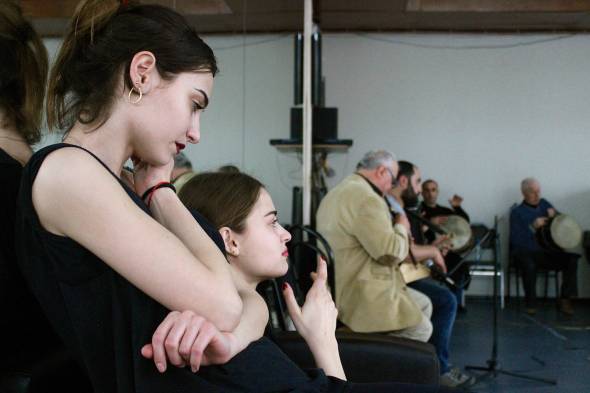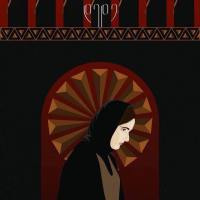Leaping and Dancing in Georgia

Dancers at Sukhishvili, the Georgian National Ballet
I walked up to the Sukhishvili dance studios off of Agmashenebeli Avenue. I had no introduction on this one, didn’t know anyone, did not make email contact and was coming in blind. And so I sidled by a few working men milling around near a bus emblazoned with Sukhishvili dancers before I entered the building. There were security guards. I tried to communicate. No English spoken here. One of the working men I had passed saw that I was trying to communicate. His English wasn’t good, but he understood that I was trying to meet someone at the studio. He motioned me to wait. Eventually a man he knew walked by and he grabbed hold of him to talk with me. His name was Tomaz and he did speak English. I explained that I was here to begin research on a documentary film on Georgian music and dance. He was pleased and explained that he was a liaison for the troupe. And that he would talk to someone about the possibility of watching the rehearsals and talking to Nino Sukhishvili, the granddaughter of the founders Iliko Sukhishvili and Nino Ramishvili. He disappeared briefly, where upon the friendly idler resumed his concern for me and after realizing that I was from Alaska was suitably curious. (Except in Los Angeles, being from Alaska is always a great conversation starter.) Tomaz returned to tell me that “Sadly Nino won’t be here until 12:00.”

In the Sukhishvili room of memories.
I came back later but she still wasn’t there. Tomaz took me into a room that was filled with Sukhishvili memorabilia; posters, costumes, etc. We talked and I explained to him the nature of my documentary idea. And he went off to check to see if Nino was back yet. And I waited and waited and waited. And was finally regretfully told by Tomas to return the next Tuesday. And he gave me a book on Sukhishvili, which fortunately was split into Georgian and English, to study up on the company before meeting Nino next week. (Books on Georgian music and dance are notably scarce in English.)

Dancers at rest, Musicians continue to play.
Tuesday came and I arrived dutifully at the appointed time. Still no Nino. But that wasn’t a problem. I left to visit the mournful one room national museum of the last dwelling of the tragic 19th Century Georgian artist Niko Pirosmani. Upon my return I breezed past the security guards only to sit and wait on a rubbery couch. I’ve discovered that often the security guards in various art institutions only keep away people who have no idea where they are. If you simply walk through the gates like you work there they won’t even look at you. Tomaz eventually showed up again and apologetically said that she still wasn’t there yet. I had a certain idea about Georgian culture by this point, so I wasn’t at all surprised or put off. He then took me into a small office that was soon occupied by an affable older dancer named Zaza, who reminded me slightly of Igor Stravinsky.

A Dancer practicing her hand gestures
But it was worth every moment. Sukhishvili is the dance troupe started back in the 1940s after the Great Patriotic War of the Soviet Union. I was familiar with their story and artistry as the main inspiration of Iliko Sukhishvili and his wife Nino Ramishvili to create a dance ensemble which took the essence Georgian folk dance traditions, while making a classical art out of it. Videos in my research had shown me men spinning and whirling; leaping high into the air and landing on their knees and toes. (!) The Sukhishvili women, meanwhile, spent much of the time on the balls of their feet, legs often hidden by gorgeous traditional dresses, creating the illusion of floating through time. They too could spin and swirl, dresses sweeping long in delayed ripples. As I sat there waiting for word I watched dancers walk by the windows of the room. I would see women the likes of which I’d never encountered before in my life, graceful with striking features and long dark hair. Men would swagger by on their way to practice. I heard the sounds of folk musicians off in another room. I desperately wanted to get to get in that room to watch the rehearsals. But I politely stayed in the trophy room and bided my time.

Working on the costumes
Eventually I was released from my waiting by the arrival of Nino Sukhishvili herself. I had missed half of the practice. Obviously the woman in charge she was nevertheless pleasant and while she didn’t have time for an interview that day she invited me to return on Thursday, my last day in Georgia, for an interview and to continue to watch more rehearsals. And then she took me with her upstairs to the actual dance studio to watch the dancers practice.

The Men dancing like athletes.
It had indeed been well worth the wait. As I entered the room men, maybe thirty in number, danced intently to a live band of folk musicians in the corner, augmented with a few modern instruments. The scent of the room was strong with male and female sweat. I sat on a couch directly in front of the wall of mirrors the dancers used for observing their own movements. I pulled out my camera and immediately started filming and taking stills. I instantly realized that it was like wildlife photography, like trying to capture birds in flight. I had a lot to learn. And the light coming in from the wall of windows behind them was too strong. I wasn’t sure exactly where I could go yet. And then the group of men lurch amass towards me, coming close enough that I could reach out and touch them if I so chose. And these men did not look like the idea of a male dancer in ballet. And their dances were not graceful. The men stomped and jumped, pranced and capered, in a way that reminded me how many of these dances were connected war and contests of strength and finesse. And all the while I was pinching myself that I was even present in this room to watch them. And then it was the women’s turn.
In Georgian folk dancing there is a clear distinction between the way the women dance and the men. And I’m glad there is. The women don’t leap into orbit and land on their knees. They dance with delicate steps slight elevated on the balls of their feet, which I can guarantee you is not easy. They have perfected the art of floating, of weightlessness, especially in their traditional costumes. They also skip and spin and swirl in utterly winsome beauty. And as I sat there watching, torn between photography and being caught up by their movements I noted the character in their faces, often strong noses and chins, nothing anemic here, but a pride of carriage and heritage that could not be duplicated. Entrancing. And there I was trying, really failing to truly capture what I was seeing. But fortunately I was allowed to come back again to try one more time before my departure from this unique land.

The Dancer Davit leaping up to meet me on the balcony.
Thursday came and I arrived on time, around noon, and was again assigned a spot to wait near the front entrance. Dancers walked by, a few seemed to recognize me. Again the practice started without me as I could hear music drifting through the corridors. But Nino eventually came and I was given an excellent interview. She pointed out several things that made sense of some of the things I had been seeing in Georgia. Sukhishvili had had an effect of collating and revivifying the dance traditions from the different regions of Georgia. She theorized that the nation’s folk dances of might have withered on the vine due to Soviet modernization, if Sukhishvili hadn’t codified the dances back in the 40s. She also gave me an interesting statistic, that fully one third of the students in Georgia took dance classes from Sukhishvili, Rustavi, Erisioni or other organizations.

Nino Sukhishvili explaining Georgian dance to me.
And that helped me to understand the comprehension among the young ballet goers that I had seen earlier. Nino did emphasize that Sukhishvili style wasn’t exactly traditional. The dances had almost been turned into a separate classical form running parallel with the French/Russian traditions of ballet. And in fact Sukhishvili style had purposely blended elements of folk, classical ballet and even some modern elements. This was particularly true in their Ramishvili style, which had met a bit more resistance since it added even more modern elements all the while based on traditional styles. Dancer Tatia Ukleba seemed to be the embodiment of this newer movement with her close cropped hair and ethereal and elongated body lines. But what occurred to me as we spoke was that dance was certainly alive in Georgia in a way that it was in few corners of Europe or the technological world.

Dancers in silhouette against the windows
Finally! I was allowed to get back to watch the dancers again. (Ah surfeit of opportunities!) This time I felt freer to find new angles to film from, including on a balcony straight above the dancers. And again I had missed a good portion of the rehearsal. But I started noticing individual dancers more; Mariam Pridonishvili, Tamar Khurtsilava, Mariami Matiashvili, Bachana Chanturia, Davit Chanishvili among them. But being in that room full of fifty or more dancers was like learning to see for the first time. I still didn’t really know what I was looking at. Dance master David Ughrekhelidze would often correct dancers for reasons I could only guess at. Soon it was time to leave. And I knew I would have to come back to get more photos and footage. But I felt completely honored to have been allowed to watch such a talented company of dancers.






Hi, wonderful post! Have you managed to finish the Documentary? Would love to see it!
All the best.
January 20, 2020 at 2:55 AM
Hi Paula, I would love to finish the documentary. I have over 40 hours of interviews. But Alas the money ran out. And I have to figure a way to find more. Thanks for your kind words.
January 20, 2020 at 2:58 AM